Most organizations take on more projects than they can realistically deliver. When teams operate in silos, resources are stretched across competing priorities, and leaders lose sight of which initiatives actually move the business forward. The outcome is familiar: lots of activity, but little meaningful progress.
Portfolio planning provides the structure to fix this. By creating a disciplined approach to selecting, prioritizing, and managing projects, it ensures every initiative aligns with broader business objectives. Done well, it helps leaders make informed trade-offs, allocate resources effectively, and keep execution tied to strategy.
This article explores the essentials of portfolio planning: the core components that make it effective, a step-by-step process for building your own plan, and proven methods to support better, data-driven decisions. With the right approach, portfolio planning transforms from a reactive task into a continuous practice that drives real strategic impact.
Try monday work managementKey takeaways
- Align projects with business goals: prevent silos and direct resources toward the initiatives with the highest impact.
- Follow a clear portfolio planning process: define objectives, assess projects, set criteria, prioritize impact, allocate resources, and monitor progress continuously.
- Apply decision-making frameworks: use methods like weighted scoring models or the BCG matrix to guide data-driven resource allocation.
- Elevate execution with monday work management: AI-powered optimization, automated resource allocation, and real-time analytics turn scattered work into strategic progress.
- Review portfolios regularly: check alignment quarterly and adjust resources monthly, focusing on five to fifteen initiatives that are properly resourced.
What is portfolio planning?
Portfolio planning is the strategic portfolio management process of selecting, prioritizing, and managing multiple projects to achieve business goals. With studies estimating that around 67% of well-formulated strategies struggle to achieve their goals due to execution challenges, it’s how organizations decide which projects deserve resources and attention — ensuring every initiative connects to larger objectives.
Think of it as orchestrating multiple projects at once. While project management focuses on delivering one initiative, portfolio planning — closely related to portfolio management — looks across all your projects to maximize overall value. You’re not just asking “how do we complete this project?” but “which combination of projects will drive the most impact?”
Portfolio planning vs portfolio management
Portfolio planning and portfolio management work together but serve different purposes. Planning happens first — it’s the strategic work of selecting which projects to pursue and how to prioritize them. Management comes next — it’s the ongoing execution and monitoring of those decisions.
Here’s how they differ in practice:
| Portfolio planning | Portfolio management |
|---|---|
| Decides which projects to start | Monitors active projects |
| Sets resource allocation strategy | Tracks actual resource usage |
| Defines success metrics | Measures performance |
| Creates the roadmap | Follows the roadmap |
Why every organization needs portfolio planning
Without portfolio planning, teams work in silos. This is a common issue, as one survey found that fewer than 30% of companies have an integrated, enterprise-wide portfolio management process. As a result, marketing might launch campaigns that don’t align with product releases, meaning marketing planning becomes disjointed. Similarly, IT may build systems that operations didn’t request, and resources scatter across low-impact work, leaving critical initiatives under-resourced.
Portfolio planning solves these challenges by adding structure to project selection and resource allocation. It provides visibility into all active work, enables informed trade-offs between competing priorities, and ensures resources are directed toward the initiatives that deliver the most value.
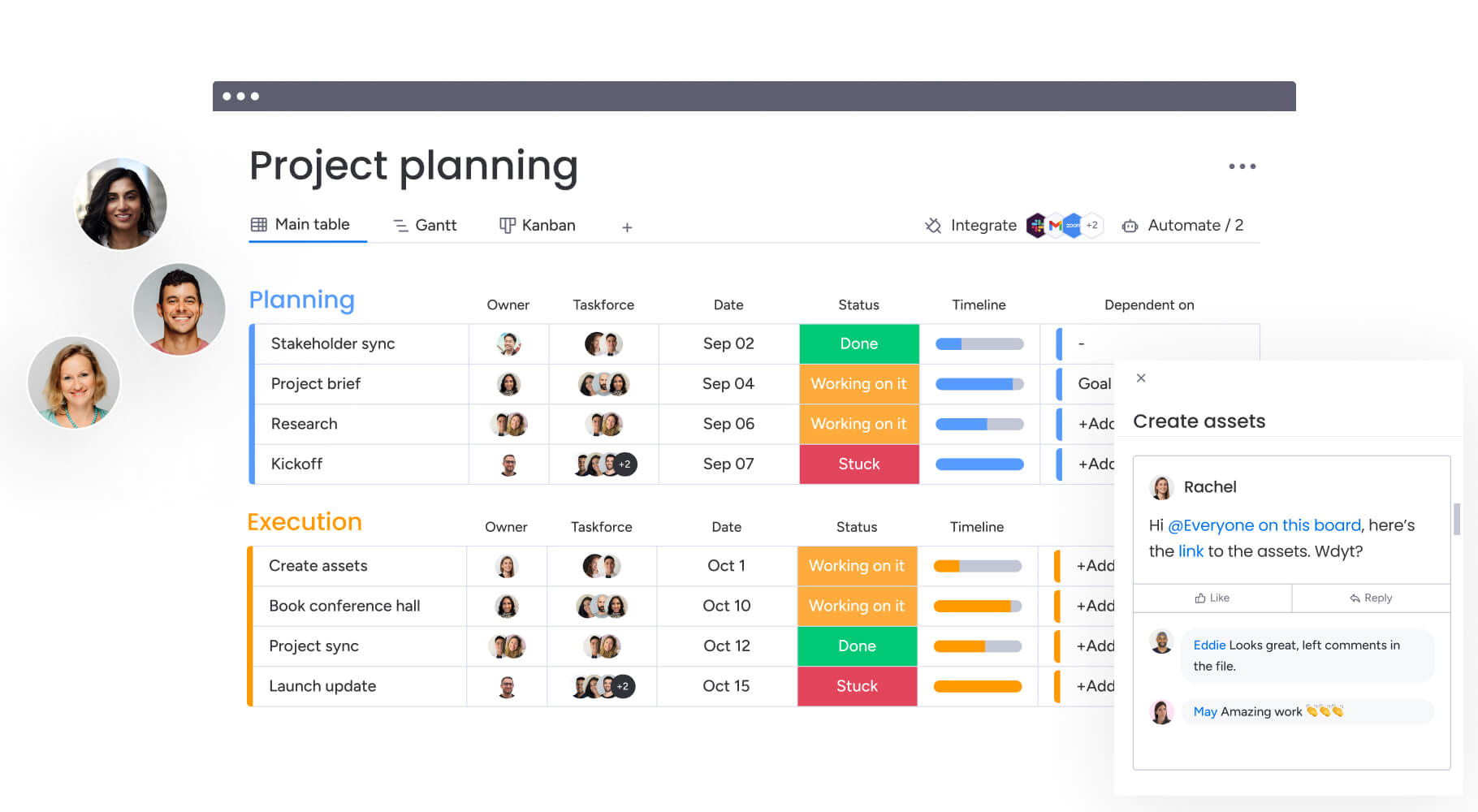
How portfolio planning works
Portfolio planning transforms strategy into action through three connected processes. Each builds on the previous one to create a comprehensive system for managing multiple projects:
Strategic alignment with business goals
Every project in your portfolio should connect to specific business objectives. This alignment starts by translating high-level goals into measurable outcomes that guide project selection.
For example, if your strategic goal is to “expand market share,” you might pursue projects focused on:
- Product development: Launch features that attract new customer segments.
- Marketing campaigns: Increase brand awareness in target markets.
- Sales enablement: Equip teams to close deals faster.
- Customer success: Improve retention to grow through referrals.
With monday work management, alignment becomes visible by linking every project to defined objectives and key results. This creates a direct line of sight from day-to-day tasks to high-level strategy, making it easier to track progress and adapt when priorities shift. The result is not just visibility but true strategic execution, where resources and effort stay focused on the initiatives that drive the business forward.
Resource optimization across projects
Resources are finite. Portfolio planning, paired with resource allocation best practices, ensures you deploy them where they’ll have maximum impact. This means understanding not just who’s available, but matching skills to project needs.
To optimize resources effectively, you must look beyond simple availability. A holistic approach considers multiple dimensions to ensure you have the right assets in the right place at the right time.
- People: Who has the right skills and capacity?
- Budget: How much can you invest in each initiative?
- Time: What are the dependencies and deadlines?
- Systems: Which platforms and systems are needed?
The goal is preventing both overallocation and underutilization. When resources are optimized, teams maintain sustainable pace while delivering maximum value.
Continuous risk management
Portfolio-level risks are different from project risks. They’re systemic issues that can impact multiple initiatives simultaneously. Portfolio planning identifies and manages these interconnected risks before they cascade.
Common portfolio risk management concerns include resource conflicts between projects, strategic misalignment as priorities evolve, and dependency chains that create domino effects. By managing risk at the portfolio level, you protect overall outcomes even when individual projects face challenges.
Try monday work management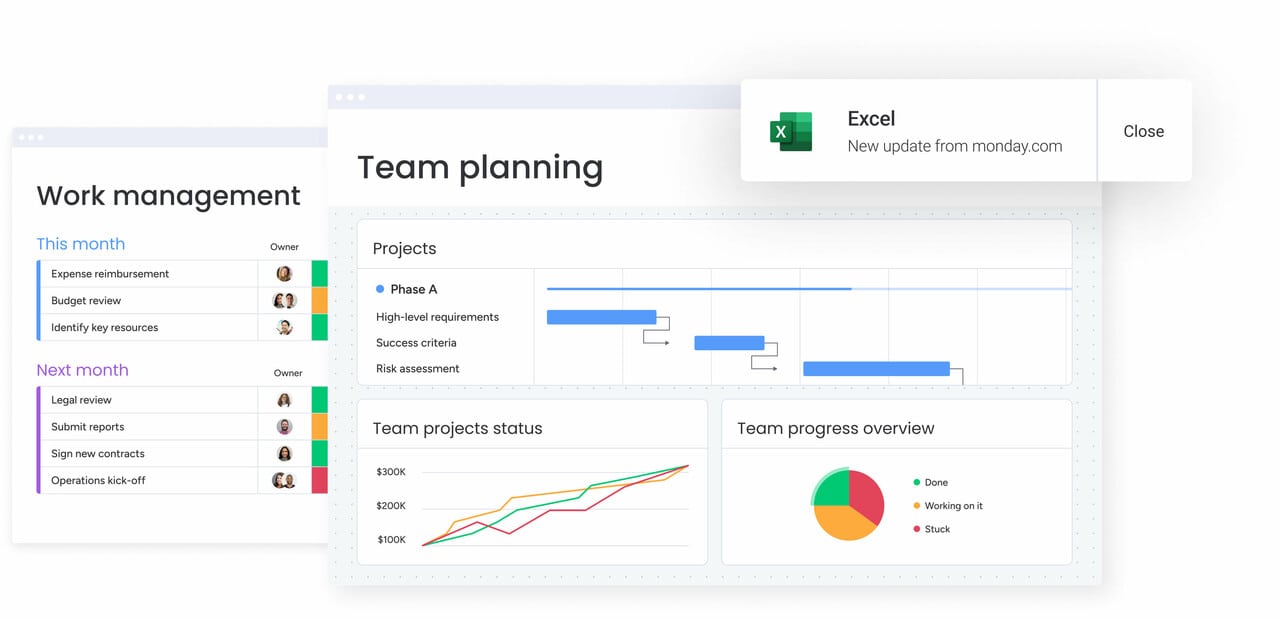
5 essential components of portfolio planning
Successful portfolio planning doesn’t happen by accident. It relies on a set of core building blocks that keep strategy, execution, and measurement connected. Miss one of these, and even the best intentions can fall short, leaving projects misaligned and resources spread too thin.
The following five components form the foundation of an effective portfolio plan. Together, they ensure every project supports business goals, resources are allocated wisely, and progress can be measured and acted on with confidence.
1. Strategic goal alignment
Goal alignment ensures every project earns its place in your portfolio. This isn’t about checking boxes — it’s about creating explicit connections between project outcomes and business objectives.
Start by defining what success looks like at the organizational level. Then cascade those objectives down to specific, measurable project outcomes, guided by corporate strategic planning principles. Each project should answer: “how does this move us closer to our strategic goals?”
2. Project prioritization framework
Not all projects are created equal. A prioritization framework helps you make consistent decisions about which initiatives deserve resources. Without this framework, the loudest voice or most urgent request wins — not necessarily the most valuable work.
Effective frameworks balance multiple factors:
- Strategic fit: How well does this align with our goals?
- Expected return: What value will this deliver?
- Resource requirements: What will this cost in time and effort?
- Risk level: What could go wrong?
3. Resource allocation strategy
Resource allocation determines how you distribute people, budget, and time across your portfolio. This strategy must be flexible enough to adapt as conditions change while maintaining focus on strategic priorities.
Consider both capacity and capability. It’s not enough to know someone is available — you need to match their skills with project requirements. monday work management’s resource management features help visualize workloads and identify optimal assignments.
4. Performance tracking metrics
You can’t manage what you don’t measure. The impact on morale is significant, as research shows that employees who understand how success is measured are twice more likely to feel motivated. Portfolio metrics go beyond individual project status to show overall health and strategic progress. They provide a high-level view that helps leaders assess whether the entire collection of projects is moving the organization toward its goals.
Key metrics to track include:
- Strategic goal progress: Are we moving toward our objectives?
- Resource utilization: Are we using capacity effectively?
- Portfolio ROI: What return are we generating?
- Risk exposure: Where are we vulnerable?
5. Governance and decision rights
Clear governance prevents delays and confusion. Define who can approve new projects, how conflicts get resolved, and when to escalate issues. Without this structure, portfolio planning becomes an exercise in politics rather than strategy.
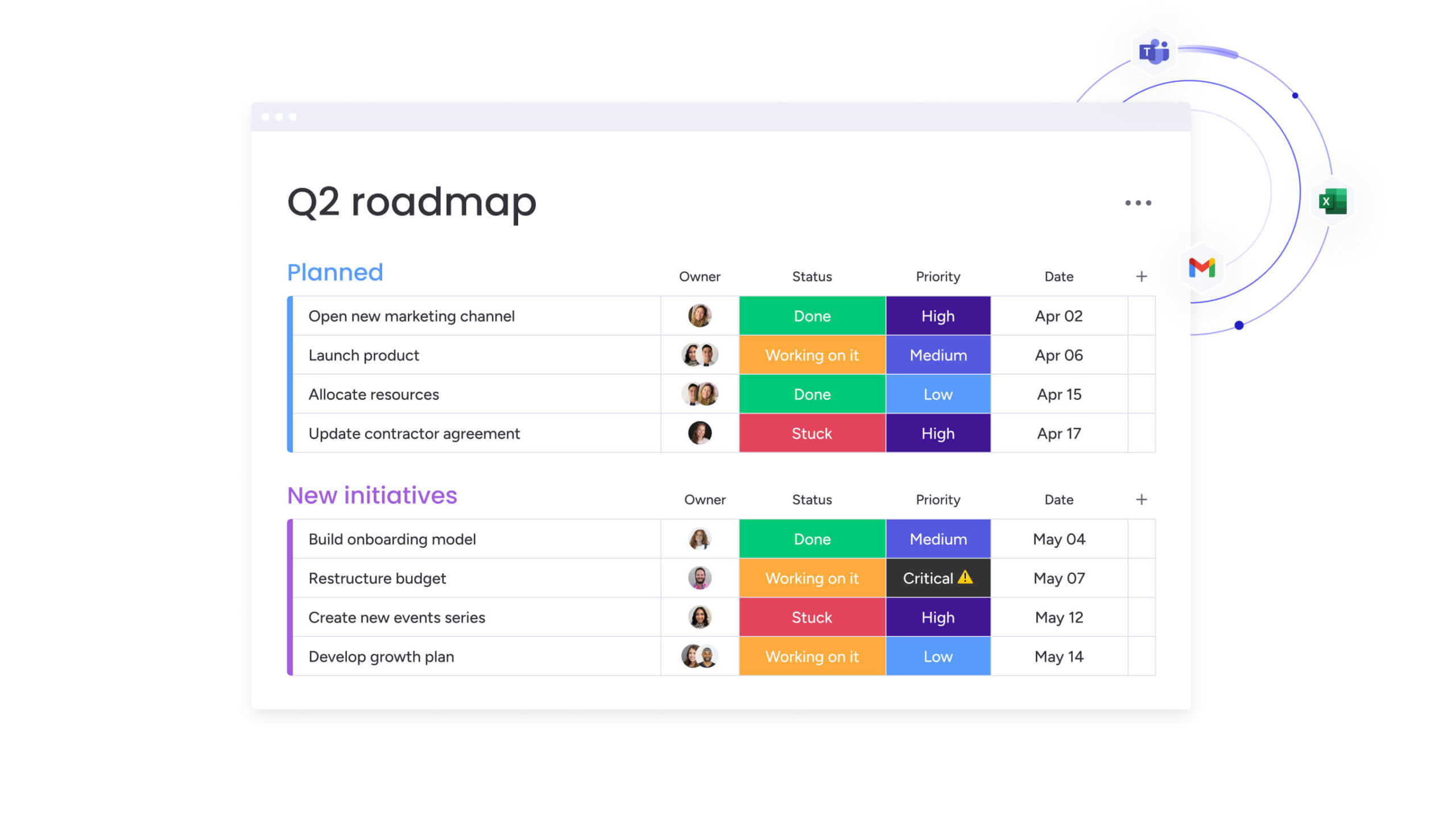
6 steps to build your portfolio plan
Creating a portfolio plan doesn’t have to be overwhelming. Follow these steps to build a plan that drives real results.
Step 1: Define strategic business objectives
Start with strategy. What are you trying to achieve as an organization? Your objectives should be specific enough to guide decisions but flexible enough to accommodate change.
Good objectives share common traits. They connect to your mission, include measurable outcomes, and balance ambition with achievability. “Increase revenue” is too vague. “Grow recurring revenue by 20% through new product adoption” gives clear direction.
Step 2: Inventory and assess current projects
Planning your future portfolio starts with a clear picture of your current state. Create an inventory that captures for each project:
- Objectives: What the project is designed to achieve.
- Resource commitments: The people, budget, and time currently allocated.
- Strategic alignment: How the project supports organizational goals.
This assessment often uncovers hidden issues, such as:
- Outdated initiatives: Projects that made sense last year but no longer align with priorities.
- Duplicate efforts: Multiple teams working toward the same outcome.
- Resource drains: Initiatives consuming significant investment without delivering real value.
Step 3: Establish clear selection criteria
Clear selection criteria ensure new projects are evaluated consistently and objectively. Effective criteria balance quantitative and qualitative factors, including:
- Financial metrics: Expected ROI, cost, or revenue impact.
- Strategic fit: Alignment with business goals and priorities.
- Risk level: Potential obstacles or uncertainties.
- Organizational readiness: Skills, capacity, and infrastructure required for success.
Weight each factor according to current business conditions to create a framework that guides sound, repeatable decisions.
Step 4: Prioritize projects for maximum impact
Apply your selection criteria to rank projects. This isn’t just about individual project value — consider how projects interact and support each other.
Some lower-scoring projects might be essential enablers for higher-value initiatives. Quick wins can build momentum for longer-term efforts. The goal is optimizing total portfolio value, not maximizing individual project scores.
Step 5: Allocate resources strategically
Once priorities are clear, the next step is translating them into actual resource commitments. Effective allocation means balancing optimization with flexibility — enough structure to support high-value initiatives, but also enough reserve capacity to handle urgent issues or unexpected opportunities.
With monday work management, this process becomes far more transparent. Leaders can:
- Visualize workloads across the entire portfolio to see where teams are overextended or underutilized.
- Model changes in real time to understand how shifting resources affects overall plans.
- Identify capacity gaps early so adjustments can be made before projects stall.
The result is a resource strategy that aligns with business priorities while staying adaptable as conditions change.
Step 6: Monitor progress and adapt
Portfolio planning isn’t a one-time exercise. Regular monitoring ensures your portfolio stays aligned with strategic objectives as conditions change.
Set up dashboards that track portfolio health, resource utilization, and strategic progress. Schedule periodic reviews to assess performance and make adjustments. The best portfolio plans evolve with your business, especially when supported by business planning software that adapts to shifting needs.
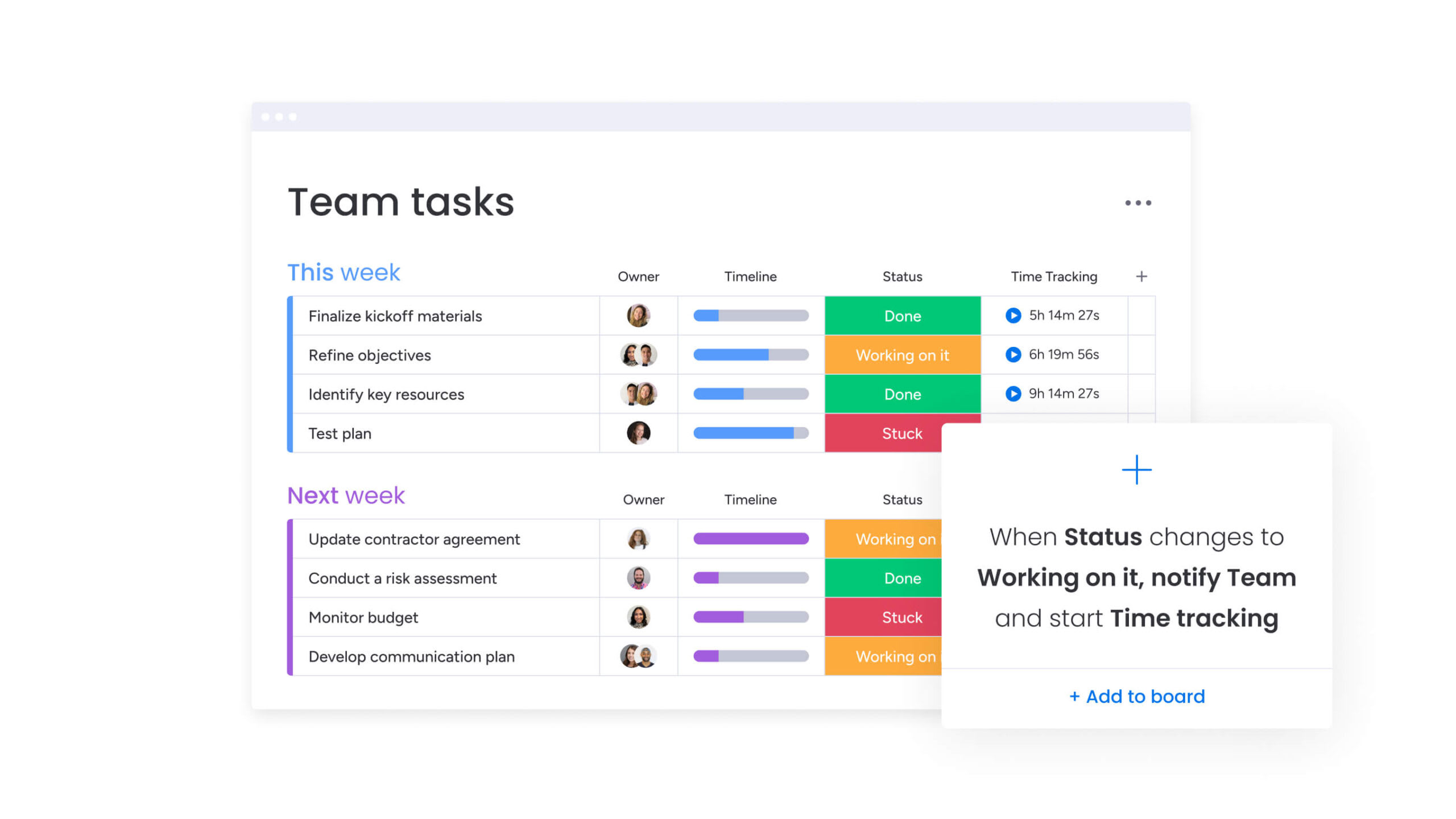
Portfolio planning methods that drive results
Different organizations need different approaches to portfolio planning. These three proven methods provide frameworks you can adapt to your specific context.
The BCG growth-share matrix for portfolios
The BCG matrix categorizes projects into four types based on strategic value and resource requirements. This visual framework helps balance your portfolio across different types of initiatives.
- Stars: High-value projects requiring significant investment.
- Cash cows: Established projects generating steady returns.
- Question marks: Emerging opportunities with uncertain outcomes.
- Dogs: Low-value projects consuming resources.
Use this framework to ensure portfolio balance. Stars drive growth but need investment. Cash cows fund other initiatives. Question marks deserve experimentation. Dogs should be eliminated to free resources.
Weighted scoring models
Scoring models bring consistency and objectivity to project evaluation. Start by defining the criteria that matter most to your organization, assign weights to reflect their importance, and then score each project against those standards. This method works because it makes trade-offs transparent, helping leaders focus on strategy rather than politics. With support for custom scoring frameworks, monday work management ensures the model reflects your organization’s unique priorities while keeping evaluations consistent across the portfolio.
Agile portfolio planning approach
Agile portfolio planning emphasizes flexibility and rapid adaptation, much like adaptive planning software approaches. Instead of annual planning cycles, you review and adjust quarterly or even monthly.
This approach works well in dynamic environments where priorities shift frequently. Start with shorter planning horizons, test assumptions through small experiments, and scale what works. Regular retrospectives help you continuously improve both outcomes and processes.
Try monday work managementWhat are the benefits of proper portfolio planning?
Strong portfolio planning creates impact across the organization, improving how resources are used, how priorities are set, and how results are measured. Over time, these benefits build on one another, turning planning from a tactical exercise into a strategic advantage that drives lasting business value.
Maximize resource utilization
Portfolio planning ensures resources are directed toward the highest-value work. Through organized capacity planning, teams can:
- Identify underutilized capacity: spot where skills and time are going unused.
- Prevent overallocation: avoid spreading people too thin across competing priorities.
- Match skills with project needs: assign the right expertise to the right initiatives.
The benefits extend well beyond efficiency. When projects align with skills and interests, engagement rises. Balanced workloads reduce burnout, and optimized resources allow organizations to achieve more without increasing investment.
Achieve strategic alignment
Every project in a well-planned portfolio pulls in the same direction. Marketing initiatives support sales goals. Technology projects enable operational improvements. Product development reinforces customer satisfaction.
This alignment accelerates progress toward strategic objectives, forming the basis of a comprehensive strategic plan. Instead of scattered efforts that may conflict or overlap, you get focused execution that compounds value. monday work management makes this alignment visible through goal-linking and progress tracking features.
Make data-driven decisions
Portfolio planning shifts decision-making from instinct to objective data. With the right framework, leaders can:
- Identify high-return projects: see which initiatives deliver the greatest value.
- Spot effective resource use: understand where time, budget, and skills are best applied.
- Anticipate risks early: track which projects carry the most uncertainty or exposure.
The result is faster, more consistent decisions. Stakeholders gain confidence when the criteria are transparent, and teams are more likely to accept prioritization outcomes when the rationale is clear.
Increase portfolio ROI visibility
Portfolio planning illuminates the return on your project investments. You’ll see not just individual project performance, but how your entire portfolio delivers value.
This visibility supports better investment decisions and clearer stakeholder communication. When you can demonstrate portfolio ROI, it’s easier to secure resources for high-value initiatives.
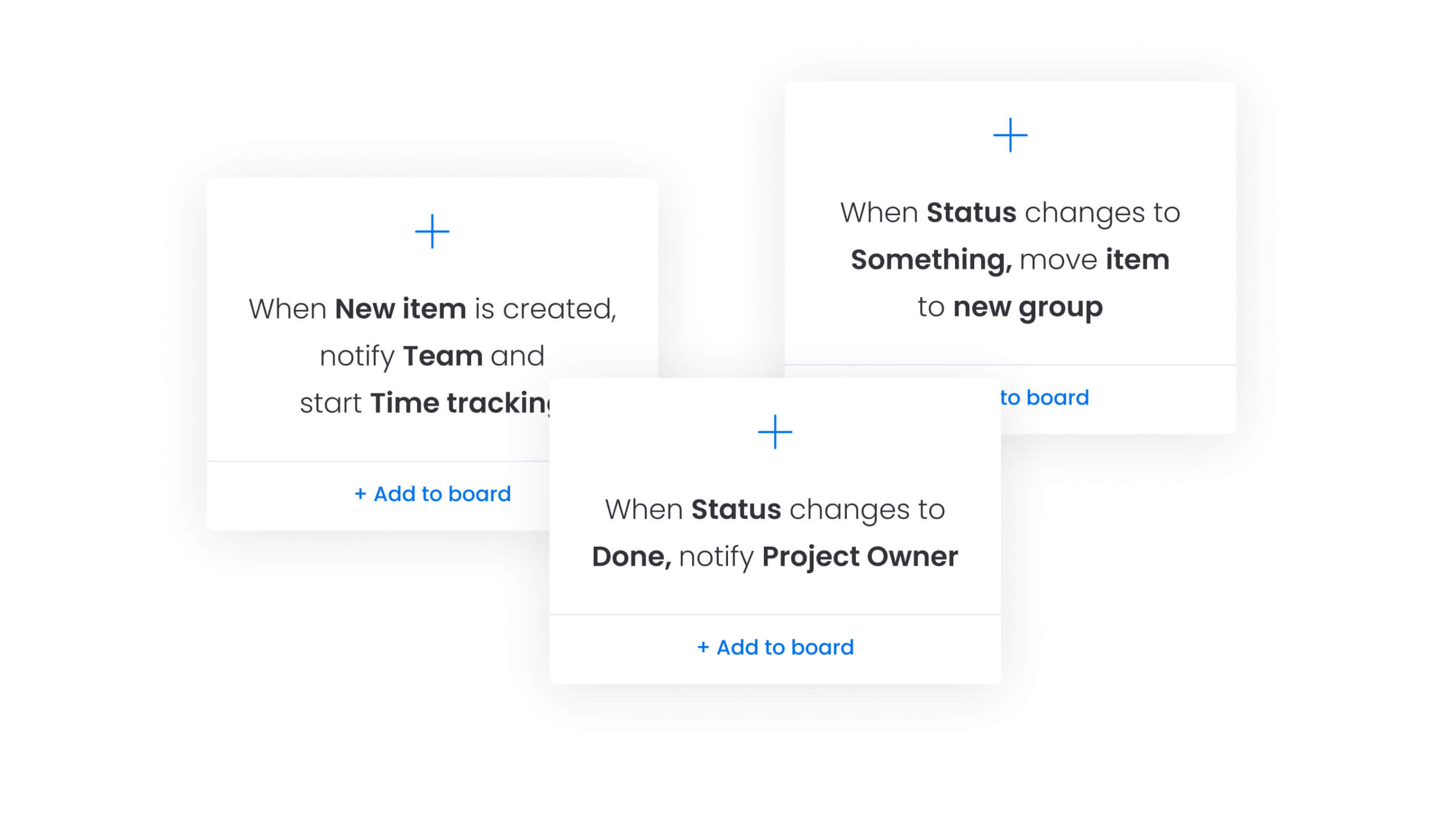
Overcome common portfolio planning challenges
Even strong portfolio planning processes face predictable challenges. Here’s how to address the most common obstacles:
Balance competing project priorities
Every department thinks their projects are most important. Without clear frameworks, these competing priorities create conflict and paralysis.
The solution is transparency. When selection criteria are explicit and consistently applied, prioritization decisions become less personal. Use objective scoring, involve stakeholders in criteria definition, and communicate decisions clearly.
Manage limited resource constraints
Resources will always be limited. The key is optimizing allocation rather than just managing scarcity.
Focus on highest-value work first. Build flexibility into your plans. Cross-train team members to reduce bottlenecks. monday work management’s resource management features help visualize constraints and identify optimization opportunities.
Secure stakeholder buy-in and support
Portfolio planning fails without stakeholder support, a challenge compounded by a common perception gap: while 45% of senior leaders believe change is managed ‘very well,’ only 23% of individual contributors agree. People resist new processes, especially when they don’t understand the value.
Build support by demonstrating quick wins. Start with a pilot program. Share success stories. Involve stakeholders in planning processes. When people see results, resistance transforms into advocacy.
Portfolio planning platforms for visual management
Managing a portfolio at scale requires more than spreadsheets. Modern platforms combine complexity with clarity, giving leaders the visibility to align strategy with execution. Visual management features are especially valuable because they translate data into views that everyone can understand, from executives to team members.
Interactive dashboard views
Dashboards give real-time visibility into portfolio performance, helping each audience focus on what matters most:
- Executives: track high-level progress toward strategic goals.
- Managers: monitor resource utilization and team capacity.
- Team members: understand priorities and how their work connects to larger initiatives.
The most effective dashboards balance depth with usability. They remain customizable for different stakeholders while maintaining consistent data. Interactive features let users drill into details without overwhelming them with information.
Timeline and Gantt visualizations
Timeline views reveal project sequencing, dependencies, and resource allocation patterns. These visualizations help identify conflicts and optimization opportunities that spreadsheets hide.
Gantt charts show how projects overlap and interact. Resource timelines highlight allocation patterns. Dependency views reveal critical paths. Visual planning makes complex portfolios manageable.
Real-time resource management
Resource management requires current data. Real-time visibility into utilization, availability, and allocation enables proactive decisions rather than reactive fixes.
Look for features that show workload distribution, skill matching, and capacity forecasting. Integration with time tracking and project updates ensures accuracy. Automated alerts highlight issues before they become critical.
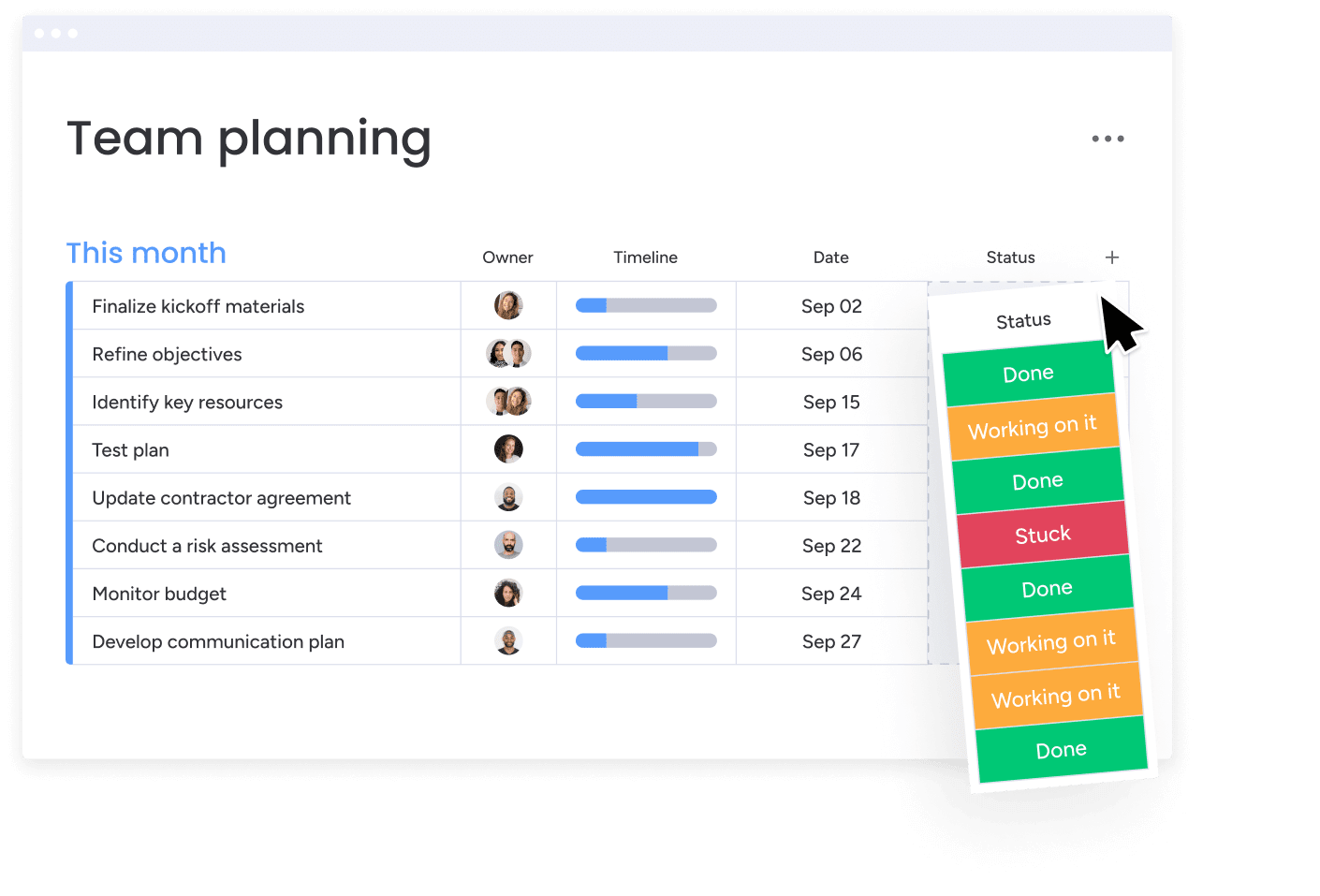
Streamline portfolio planning with monday work management
Effective portfolio planning depends on more than just process. It requires a platform that eliminates silos, handles complexity, and makes strategy visible across the organization. By combining automation, AI, and real-time analytics, monday work management turns scattered project data into a single source of truth. The result is a planning environment that adapts to your methodology while providing the structure needed for scalable execution.
AI-powered portfolio optimization
AI in monday work management reduces manual effort while elevating decision-making quality. Key capabilities include:
- AI Blocks: automate routine tasks such as categorizing projects, extracting key details, and summarizing status reports.
- Risk management tools: flag potential issues across projects before they escalate.
- Resource optimization features: recommend ideal assignments based on skills, availability, and strategic priorities.
These capabilities free teams from repetitive work and provide leaders with insights that improve both speed and accuracy in portfolio decisions.
Automated resource allocation
Manual resource planning doesn’t scale. monday work management automates allocation recommendations based on skills, availability, and strategic priorities.
The platform considers multiple factors simultaneously. Who has the right skills? Who has capacity? What are the dependencies? Automation handles the complexity while you focus on strategic decisions.
Live portfolio analytics
Real-time analytics in monday work management make portfolio health easy to understand and act on. Core capabilities include:
- Customizable dashboards: track strategic progress, resource utilization, and risk indicators at a glance.
- Automated reporting: deliver tailored updates to different stakeholders without extra effort.
- Proactive alerts: flag critical issues the moment they arise.
- Trend monitoring: spot emerging problems early and adjust before they escalate.
By turning raw data into actionable insights, these analytics give leaders the clarity to make faster, more confident portfolio decisions.
Seamless cross-team collaboration
Portfolio planning requires coordination across departments. monday work management provides shared workspaces where teams collaborate while maintaining their own workflows.
Integration with communication tools keeps everyone connected. Shared dashboards ensure alignment. Collaborative planning features support decision-making. The platform brings teams together by providing a flexible environment that adapts to their unique workflows.
Try monday work managementFrequently asked questions
How often should organizations review their portfolio plans?
Organizations should review portfolio plans quarterly for strategic alignment, monthly for resource adjustments, and integrate operational planning as conditions evolve. Major reviews every three to six months allow for strategic pivots while continuous monitoring through dashboards ensures you catch issues early.
What is the ideal number of projects in a portfolio?
The ideal portfolio size ranges from 5-15 major initiatives for most mid-size companies. Focus on projects you can adequately resource and manage effectively rather than maximizing quantity.
How do you measure portfolio planning success?
Portfolio planning success shows through strategic goal achievement, resource utilization rates, and portfolio ROI. Track on-time delivery, decision-making speed, and cross-functional alignment as key indicators.
Can small businesses benefit from portfolio planning?
Small businesses gain significant value from portfolio planning when managing growth initiatives with limited resources. Even informal planning helps prioritize investments and prevent resource conflicts.
How does AI enhance portfolio planning processes?
AI enhances portfolio planning through automated scoring, resource optimization, and predictive analysis. Platforms identify gaps, suggest priority adjustments, and optimize allocation based on real-time data.
What skills do portfolio planners need?
Portfolio planners need strategic thinking, financial analysis, and stakeholder management abilities. They balance analytical skills with communication expertise to facilitate decisions and translate strategy into actionable plans.
 Get started
Get started 

